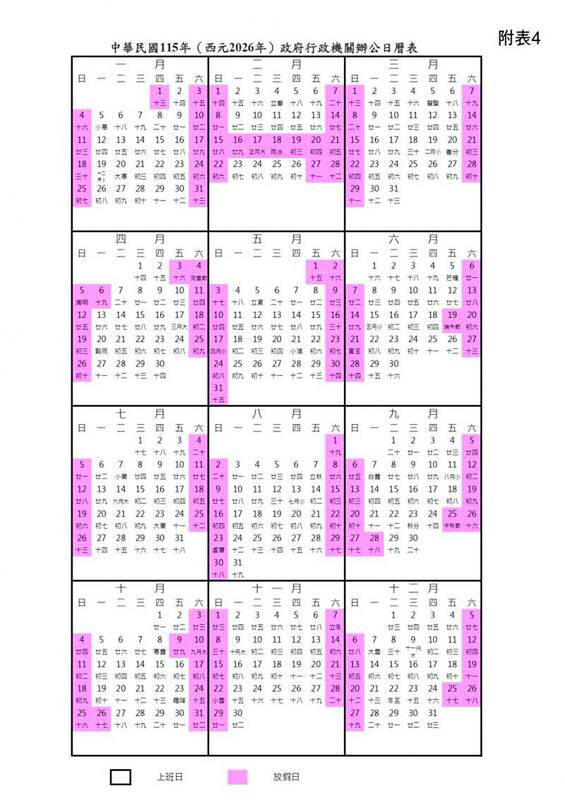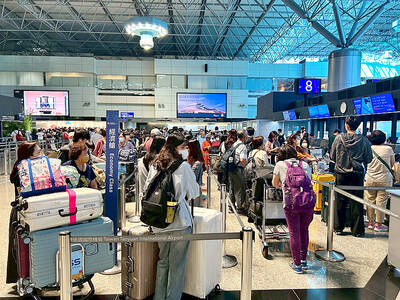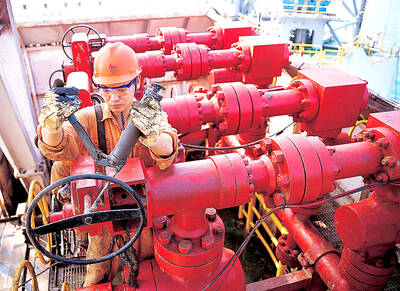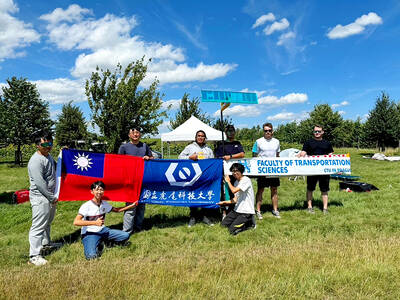Taiwan is to have nine extended holidays next year, led by a nine-day Lunar New Year break, the Cabinet announced yesterday.
The nine-day Lunar New Year holiday next year matches the length of this year’s holiday, which featured six extended holidays.
The increase in extended holidays is due to the Act on the Implementation of Commemorative and Festival Holidays (紀念日及節日實施條例), which was passed early last month with support from the opposition Chinese Nationalist Party (KMT) and Taiwan People’s Party.

Photo courtesy of the Directorate-General of Personnel Administration
Under the new act, the day before Lunar New Year’s Eve is also a national holiday, and Labor Day would no longer be limited to the private sector.
The legislation also designates Sept. 28 (Confucius’ Birthday, also known as Teachers’ Day), Oct. 25 (marking the end of Japanese colonial rule in 1945 and the anniversary of the Battle of Guningtou in Kinmen in 1949) and Dec. 25 (Constitution Day) as new national holidays.
The act came into effect following a presidential decree issued late last month, which decided that these three new holidays should come in the second half of this year.
According to the latest calendar released by the Cabinet’s Directorate-General of Personnel Administration, the other eight extended holidays next year would include two four-day breaks and six three-day weekends.
The first four-day holiday would come in early April, combining Children’s Day and Tomb Sweeping Festival.
The second is to fall in late September, covering Mid-Autumn Festival and Teachers’ Day.
The calendar stipulates that when a national holiday falls on a Saturday, the make-up day shall be on the preceding Friday, and when it falls on a Sunday, the make-up day shall be the following Monday.
However, if a national holiday falls on a Thursday — as in Constitution Day next year — no day off would be given on Friday to avoid the need for a make-up workday.
The agency said that the new calendar applies only to public servants and employees of state-run enterprises.
Workers in other sectors — such as police, firefighters, coast guard personnel and military staff — may adjust their schedules according to operational needs.

The Chinese military has built landing bridge ships designed to expand its amphibious options for a potential assault on Taiwan, but their combat effectiveness is limited due to their high vulnerability, a defense expert said in an analysis published on Monday. Shen Ming-shih (沈明室), a research fellow at the Institute for National Defense and Security Research, said that the deployment of such vessels as part of the Chinese People’s Liberation Army (PLA) Navy’s East Sea Fleet signals a strong focus on Taiwan. However, the ships are highly vulnerable to precision strikes, which means they could be destroyed before they achieve their intended

About 4.2 million tourist arrivals were recorded in the first half of this year, a 10 percent increase from the same period last year, the Tourism Administration said yesterday. The growth continues to be consistent, with the fourth quarter of this year expected to be the peak in Taiwan, the agency said, adding that it plans to promote Taiwan overseas via partnerships and major events. From January to June, 9.14 million international departures were recorded from Taiwan, an 11 percent increase from the same period last year, with 3.3 million headed for Japan, 1.52 million for China and 832,962 to South Korea,

SOVEREIGNTY: The rigs show that Beijing ‘rejects Taiwan’s jurisdiction’ by building in areas where Taipei demands permission to build or alter installations Chinese oil rigs have been sighted just 26 nautical miles (42km), from Taiwan’s exclusive economic zone (EEZ) near Pratas Island (Dongsha Island, 東沙島), posing a threat to Taiwan’s sovereignty if left unchallenged, a brief published by the Jamestown Foundation on Tuesday said. Pratas Island, 444km from Kaohsiung, is northeast of the South China Sea and houses a Taiwanese garrison. The brief, titled “Rigging the Game: PRC Oil Structures Encroach on Taiwan’s Pratas Island” — referring to the People’s Republic of China — analyzed photographs and said that Beijing’s tools to pressure Taiwan now include oil rigs. “Oil rigs now constitute part of Beijing’s

The Taiwan Experience Education Program (TEEP) has funded short-term internships in Taiwan for more than 4,500 young people from more than 40 countries since 2015, with the goal of attracting and retaining international talent, the Ministry of Education said yesterday. Fifty-five colleges launched 514 projects this year, including in fields such as semiconductors, artificial intelligence, medicine and biotechnology, green energy, and sustainability, it said. The program provides research and practical internships in Taiwan for two to six months, and offers cultural exchange and networking opportunities, the ministry said. For example, National Formosa University’s Embedded System and Autopilot Laboratory developed two solar-powered drones in